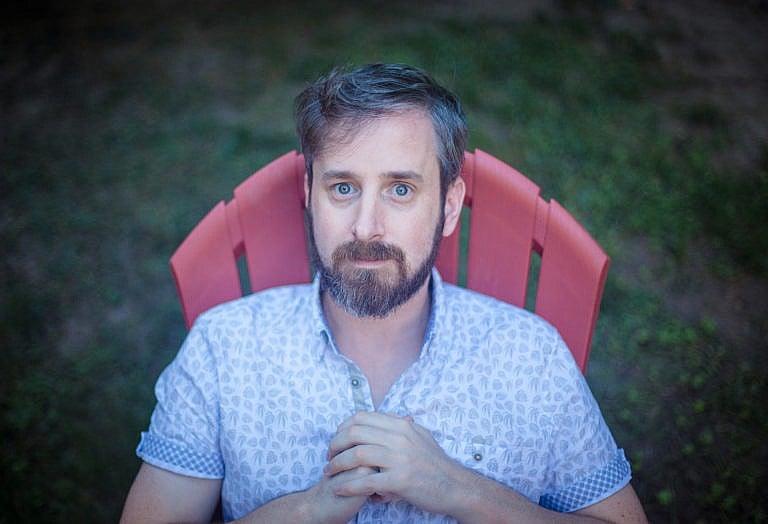Meet the Canadian bringing Batman into a new era
As the new lead writer for Batman, Chip Zdarsky wants to explore the superhero’s weaknesses

Zdarsky, a.k.a. Steve Murray, has worked as an illustrator for national newspapers. He co-created the lauded (and banned) comic book series Sex Criminals.
Share
A couple of years before the pandemic, Chip Zdarsky had a funny idea for a Comic-Con panel: a PowerPoint presentation about why he should be the next writer for Batman, rife with asinine ideas and terrible credentials like “I’m very strong” and “I’ve never shied away from punching clowns.”
It was classic Chip Zdarsky, the alter ego of Canadian comic book writer and illustrator Steve Murray, who once described his alternate identity as “an idiot who doesn’t know what [he’s] doing.” It was Zdarsky who launched a world tour that began and ended after one night in Sault Ste. Marie, Ontario; who had a months-long virtual friendship with the Facebook account of an Applebee’s restaurant in Barrie, Ontario; who held a one-man comic convention, dubbed Zdarscon, on the sidewalk across the street from Toronto’s hugely popular Fan Expo.
Ultimately, Zdarsky didn’t go through with the Batman gag, because by the time he thought of it, he had landed a gig writing a Spider-Man series and won multiple Eisner Awards (think the Oscars, but for comics). “I had the sad realization that I couldn’t play the outsider-loser anymore,” Zdarsky says. “You can’t be ‘Oh, look at me! I’m such an unsuccessful dummy’ when you’re writing books for Marvel and DC.”
In a case of life imitating fiction—or maybe reading Zdarsky’s mind—DC Comics recently named him the next writer for its flagship series: Batman. The Dark Knight is the alter ego of Bruce Wayne, a billionaire with a relentless work ethic. Zdarsky, a self-deprecating sad-sack cartoonist who is himself an alter ego, seems like an oddly perfect fit.
It was around the turn of the century, while Steve Murray was in his early 20s and working as a newspaper illustrator, that he created Chip Zdarsky. The last name was taken from a close friend’s ex-girlfriend; the first name was a nod to Peanuts creator Charles Schulz. Murray used the pseudonym for his work in comics, the nature of which sometimes seemed unbefitting of someone also working for national newspapers like the Globe and Mail or the National Post. “I was pretty intense about keeping those things really separate back in the day,” Zdarsky says. “Originally, Steve Murray didn’t exist online. I was just Chip Zdarsky making my dumb little comics and having fun with my nerd friends on the internet.”

That is until he started to do more high-profile (and often ridiculous) work at the paper, as Murray. He reported from a nudist colony, scaled Toronto’s city hall wearing a Spider-Man costume and even had a failed mayoral run. “Chip used to wear a cowboy hat, which was kind of a divider between personas,” says Kagan McLeod, an illustrator and friend since their days at the National Post graphics department. “But I don’t think he acts any differently.”
One time, at the 2003 San Diego Comic-Con, Zdarsky was packed inside a Hyatt hotel elevator alongside convention exhibitors. As everyone surely noticed, Marvel Comics’ editor-in-chief Joe Quesada was crammed in the elevator as well. As others stared blankly in silence amid the complete lack of elbow room, Zdarsky lifted up his large unwieldy art case and asked aloud: “Would you look at my portfolio, sir?”
A decade later, people like Quesada were keen to see Zdarsky’s work. In 2013, he co-created the R-rated hit comic book series Sex Criminals, the story of a bank-robbing couple who stop time when they orgasm, which Apple banned on the ComiXology app and Time magazine ranked as the number-one comic of the year. Murray left his job at the Post so Zdarsky could pursue comics full-time.
The rigour of daily news reporting proved an asset. “In baseball, you have the five-tool player,” says Matt Fraction, the writer and co-creator of Sex Criminals, using a term to describe the rare athlete who excels in all the major physical categories. “If comics has an equivalent, the first tool is: ‘Can you meet deadlines?’ Chip has that newspaper background and he’s relentless.” Zdarsky landed jobs writing for well-known characters like Howard the Duck, Jughead and Daredevil. It seemed only a matter of time before DC came calling with the chance to write about the Dark Knight.
Zdarsky says he is hopeful he’s found something fresh to bring to a character who has been thoroughly chronicled and obsessively followed. A common critique of Batman is that he glamorizes a toxic kind of masculinity—hiding his vulnerability and acting out his aggression. Zdarsky says he’s interested in exploring these issues around Batman; his previous work on the Daredevil franchise explored the ramifications of vigilante violence. He likes to think the comic book version of Batman has more nuance than those seen in the movies—he’s less the brooding billionaire, more the complicated and compassionate hero with an army of like-minded individuals who help him do justice the way he sees fit. And it’s worth asking whether they are in the right. “Who holds them all accountable?” Zdarsky says.
Batman has a pretty solid track record of saving Gotham City, Earth and the universe, but Zdarsky says the most interesting way forward in the storytelling is to look at the character’s fallibility. “If he’s not perfect, then he can’t just be allowed to do whatever he wants,” Zdarsky says. His first outing as lead writer is an arc about mistakes from Batman’s youth catching up to him—and whether he can deal with the fallout. Long-time fans need not worry that Zdarsky’s taking things too far afield. “There’s punching,” he promises.
This article appears in print in the July 2022 issue of Maclean’s magazine. Subscribe to the monthly print magazine here, or buy the issue online here.